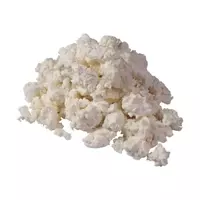Cottage cheese

A traditional type of cheese for Northern and Eastern Europe is a fermented milk product, which is obtained by fermenting milk with the subsequent removal of whey - cottage cheese. It is officially accepted to classify it by the percentage of fat. In accordance with this, they distinguish:
fatty cottage cheese (18%);
semi-fat cottage cheese (9%);
defatted cottage cheese (less than 3%).
The latter, by the way, includes grained cottage cheese, which has recently been especially loved by our compatriots for its peculiar structure and tenderness. The calorie content of cottage cheese is directly related to its fat content.
Before use, it is customary to wipe the cottage cheese or pass it through a meat grinder to obtain a more delicate consistency and uniformity. Dishes with this loose snow-white mass are prepared in various ways: boiled, baked, fried, seasoned with sugar, butter or sweet sauce.
The field of culinary art offers a huge number of options for preparing delicious dishes based on cottage cheese: cheesecakes, cheesecakes, various desserts, rolls with cottage cheese, pies with curd filling, cottage cheese cookies. But the most useful way to use this product in food is called the natural raw species. It is in this way that all the nutritional qualities and miraculous properties of cottage cheese are manifested.
In ancient times, when there were no refrigerators, this product was pressed for the winter. It became so hard that even buttons were made from cottage cheese. Today, if the quality of the purchased cottage cheese is still questionable, it is recommended to be used in recycled form.
Remember that cottage cheese is a product with a very high protein content, which is why you should not abuse it, but eat in small portions. It needs to be stored exclusively in the refrigerator, due to the fact that it represents an excellent environment for the development of disease-causing bacteria and microbes.
The benefits of cottage cheese
Everyone knows the benefits of cottage cheese for children and adults, since it contains an important macronutrient - calcium. In addition, it is also an excellent source of protein, which is absorbed by the body much better than meat protein, and also takes part in the formation of cells, immune bodies and enzymes.
The benefits of cottage cheese are also evidenced by the fact that it is rich in iron, which regulates the level of hemoglobin in the blood, and mania, which is an important element for the normal life of all organs.
The harm of cottage cheese
Currently, cottage cheese is one of the most necessary and sought-after food products, which finds its application not only in the field of dietetics, but also occupies an honorable place among cosmetology products. Its useful properties are obvious, but the harm of cottage cheese can manifest itself with the individual intolerance of this snow-white product and its improper storage when harmful bacteria develop. In this regard, it is recommended to take a responsible approach to the choice of cottage cheese: when buying, make sure that it is fresh and make sure that you have no personal hostility to this product by consulting a specialist.
curd 136 kCal
The energy value of cottage cheese (Ratio of proteins, fats, carbohydrates - ju):
Proteins: 21 g (~ 84 kCal)
Fats: 4g (~ 36kCal)
Carbohydrates: 3g (~ 12kCal)
Energy ratio (bj | y): 62% | 26% | 9%
 Español
Español Français
Français Português
Português Русский
Русский 简体中文
简体中文 繁體中文
繁體中文 日本語
日本語 한국어
한국어 العربية
العربية Türkçe
Türkçe Қазақ
Қазақ Deutsch
Deutsch Italiano
Italiano Українська
Українська
